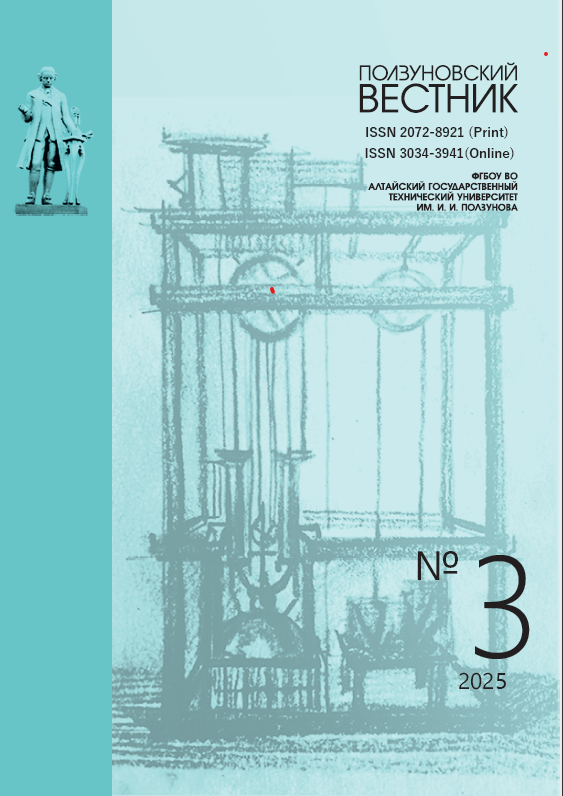РАЗРАБОТКА И ПРОГНОЗИРОВАНИЕ СВОЙСТВ НОВОГО БИОПЕПТИДА ДЛЯ ДИЕТИЧЕСКОГО ПИТАНИЯ
MSGTOG
DOI:
https://doi.org/10.25712/ASTU.2072-8921.2025.03.005Ключевые слова:
профилактическое питание, диетическое питание, функциональные ингредиенты, сахарный диа-бет второго типа, пептиды, синтез пептидов, макроциклизация, лактамизация.Аннотация
Пептиды играют ключевую роль в пищевой промышленности и фармацевтике, однако их применение в диетических и клинических целях часто ограничивается низкой стабильностью в организме. Авторами работы предложен новый «сшитый» биопептид GD-20, синтезированный на основе циклического пептида [Nphe5]SFTI-1(100). Анализ аминокислотного состава, молекулярной массы и структуры свидетельствуют о значительном терапевтическом потенциале GD-20 и его высокой устойчивости к протеолизу. Значение показателя Fsp3 (0,78) указывает на перспективность использования пептида в качестве биологически активного вещества, устойчивого к протеолизу в желудочно-кишечном тракте. Установлено, что GD-20 не содержит антигенных детерминант, а значит, не вызывает аллергических реакций, что делает его безопасным для применения в составе пищевых продуктов диетического и профилактического назначения. Прогнозируемая высокая биологическая активность пептида (0,916819 ед. при максимальной 1,0 ед.) подтверждает его потенциал в качестве функционального ингредиента, обеспечивающего профилактику сахарного диабета 2 типа. Полученные результаты подтверждают возможность разработки новых, устойчивых к деградации пептидов с улучшенными фармакокинетическими характеристиками.
Библиографические ссылки
A. Henninot, J.C. Collins, J.M. Nuss. The cur-rent state of peptide drug discovery: back to the future? J. Med Chem. 61 (2018). 1382-1414. https://doi.org/10.1021/ acs.jmedchem.7b00318.
M. Muttenthaler, G.F. King, D.J. Adams, [et al.]. Trends in peptide drug discovery, Nat. Rev. Drug Dis-cov. 20 (2021). 309-325. https://doi.org/10.1038/s41573- 020-00135-8.
F.J. Chen, N. Pinnette, F. Yang, [et al.]. A cyste-ine-directed proximity-driven crosslinking method for native peptide bicyclization, Angew. Chem. Int Ed. Engl. 62 (2023). e202306813. https://doi.org/10.1002/anie.202306813.
D.J. Drucker. Advances in oral peptide thera-peutics, Nat. Rev. Drug Discov. 19 (2020). 277-289. https://doi.org/10.1038/s41573-019-0053-0.
L. Liu, X. Fan, B. Wang, [et al.]. P(III) - Directed Late-Stage Ligation and Macrocyclization of Peptides with Olefins by Rhodium Catalysis, Angew. Chem. Int Ed. Engl. 61 (2022). e202206177. https://doi.org/10.1002/anie.202206177.
A.S. Mackay, J.W.C. Maxwell, M.J. Bedding, [et al.]. Electrochemical modification of polypeptides at selenocysteine, Angew. Chem. Int Ed. Engl. 62 (2023). e202313037. https://doi.org/10.1002/anie.202313037.
D. Garcia Jimenez, V. Poongavanam, J. Kihlberg. Macrocycles in drug discovery-learning from the past for the future, J. Med Chem. 66 (2023) 5377-5396. https://doi.org/10.1021/acs.jmedchem.3c00134.
D. Sethio, V. Poongavanam, R. Xiong, [et al.]. Simulation reveals the chameleonic behavior of macrocycles, J. Chem. Inf. Model 63 (2023). 138-146. https://doi. org/10.1021/acs.jcim.2c01093.
H.Y. Chow, Y. Zhang, E. Matheson, [et al.]. Ligation tech-nologies for the synthesis of cyclic peptides, Chem. Rev. 119 (2019). 9971-10001. https://doi.org/10.1021/acs.chemrev.8b00657.
J. Iegre, J.S. Gaynord, N.S. Robertson, [et al.]. Twocomponent stapling of biologically active and conformationally constrained peptides: past, present, and future, Adv. Ther. 1 (2018). 1800052. https://doi.org/10.1002/adtp.201800052.
X. Li, Y. Zou, H.G. Hu. Different stapling-based peptide drug design: mimicking ahelix as inhibitors of protein-protein interaction, Chin. Chem. Lett. 29 (2018). 1088-1092. https://doi.org/10.1016/j.cclet.2018.01.018.
Y.W. Zhang, J.B. Guo, J.J. Cheng, [et al.]. High-throughput screening of stapled helical peptides in drug discovery, J. Med Chem. (2022). https://doi.org/ 10.1021/acs. jmedchem.2c01541.
X. Li, S. Chen, W.D. Zhang, [et al.]. Stapled hel-ical peptides bearing different anchoring residues, Chem. Rev. 120 (2020). 10079-10144. https://doi.org/10.1021/acs.chemrev. 0c00532.
M. Buyanova, D. Pei. Targeting intracellular protein-protein interactions with macrocyclic peptides, Trends Pharm. Sci. 43 (2022). 234-248. https://doi.org/ 10.1016/j.tips.2021.11.008.
M.G. Ricardo, A.M. Ali, J. Plewka, [et al.]. Multi-component peptide stapling as a diversity-driven tool for the development of inhibitors of protein-protein in-teractions, Angew. Chem. Int Ed. Engl. 59 (2020). 5235-5241. https://doi.org/ 10.1002/anie.201916257.
A.M. Ali, J. Atmaj, N. Van Oosterwijk, [et al.]. Stapled peptides inhibitors: a new window for target drug discovery, Comput. Struct. Biotechnol. J. 17 (2019). 263-281. https://doi.org/10.1016/j.csbj.2019.01.012.
W. Li, F. Separovic, N.M. O’Brien-Simpson, [et al.]. Chemically modified and conjugated antimicrobial peptides against superbugs, Chem. Soc. Rev. 50 (2021) 4932-4973. https://doi.org/10.1039/d0cs01026j.
M.H. Wu, Q. Chen, Y.D. Wang, [et al.]. Structural modification and antitumor activity of antimicrobial pep-tide HYL, Chin. Chem. Lett. 31 (2020). 1288-1292. https://doi.org/10.1016/j.cclet.2019.10.013.
A.M. Felix, E.P. Heimer, C.T. Wang, [et al.]. Syn-thesis, biological activity and conformational analysis of cyclic GRF analogs, Int. J. Pept. Protein Res. 32 (1988). 441-454. https://doi.org/10.1111/j.1399-3011.1988.tb01375.x.
J.W. Taylor. The synthesis and study of side-chain lactam-bridged peptides, Biopolymers 66 (2002). 49-75. https://doi.org/10.1002/bip.10203.
Yulei Li, Minghao Wu, Yinxue Fu, Jingwen Xue, Fei Yuan, Tianci Qu, Anastassia N. Rissanou, Yilin Wang, Xiang Li, Honggang Hu. Therapeutic stapled peptides: Efficacy and molecular targets, Pharmacologi-cal Research, Volume 203, 2024, 107137, ISSN 1043-6618. https://doi.org/10.1016/ j.phrs.2024.107137.
S. Mahesh, V. Adebomi, Z.P. Muneeswaran, [et al.]. Bioinspired nitroalkylation for selective protein modification and peptide stapling, Angew. Chem. Int Ed. Engl. 59 (2020). 2793-2801. https://doi.org/10.1002/anie.201908593.
M. Moiola, M.G. Memeo, P. Quadrelli, stapled peptides-a useful improvement for peptide-based drugs, Molecules 24 (2019). https://doi.org/10.3390/ molecules 24203654.
J. Liu, P. Wang, Z. Yan, [et al.]. Recent advanc-es in late-stage construction of stapled peptides via C-H activation, Chembiochem 22 (2021) 2762-2771. https://doi.org/10.1002/ cbic.202100044.
X. Li, W.D. Tolbert, H.G. Hu, [et al.]. Dithiocar-bamate-inspired side chain stapling chemistry for pep-tide drug design, Chem. Sci. 10 (2019) 1522-1530. https://doi. org/10.1039/c8sc03275k.
Загрузки
Опубликован
Как цитировать
Выпуск
Раздел
Лицензия
Copyright (c) 2025 Сергей Леонидович Тихонов 1, Наталья Валерьевна Тихонова, Ольга Олеговна Бабич, Станислав Алексеевич Сухих, Евгений Борисович Сысуев, Дарья Александровна Зверева

Это произведение доступно по лицензии Creative Commons «Attribution» («Атрибуция») 4.0 Всемирная.
















 .
. Контент доступен под лицензией
Контент доступен под лицензией 
